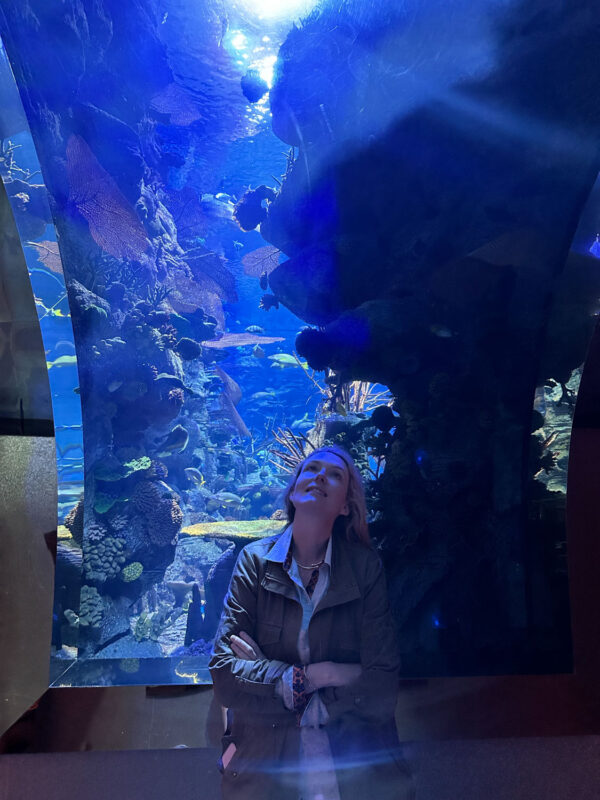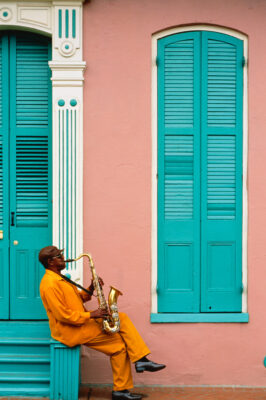
High and low
A Tale of Two Restaurants
Dining at Dubai’s most memorable eateries—one half a mile in the sky, the other under water.
What worried me was the elevator. I was in Dubai, and I was determined to eat at At.mosphere in the Burj Khalifa, a much-touted restaurant in the tallest building in the world. I’m not afraid of heights, but. Would my stomach make it to the 122nd floor?
The goal of the “Gulf Tiger”—Dubai’s rapid economic growth—has, since its inception, been to bring on the razzmatazz.
The city’s contemporary architecture boom began in earnest around 1980 with the Dubai World Trade Center, completed in 1979 by British architect John R. Harris. But it was the tallest building in the world, Burj Khalifa, and one of the most unusual, the Burj Al Arab, that grabbed world headlines. They both have restaurants—the first at the top of the world, the second surrounded by an aquarium.

At.mosphere in the Burj Khalifa is on the 122nd floor—a mere 40 floors from the very top. The tower (completed in 2009 and created by Adrian Smith of Skidmore, Owings & Merrill—the same firm that designed the Sears Tower in Chicago), is 829 meters from top to bottom (just over half a mile). Built to garner international attention and attract investment, it was Sheikh Mohammed bin Rashid Al Maktoum (ruler of Dubai)’s baby, and was originally known as the Burj Dubai—until Dubai had to turn to neighboring Abu Dhabi for a cash infusion to refinance their debt, which had spiraled out of control during the 2008 recession. In 2010, the building was renamed in honor of Abu Dhabi’s ruler, Khalifa bin Zayed Al Nahyan.
My fears about the elevator were misplaced; we were whizzed up to the restaurant in less than two minutes. The decor—lots of dark green and nautical round peep holes—was attractive in a crested-velvet-slipper kind of way. Gold sculptures and chandeliers announced that you were in a monument to the modern gilded age.
Our table was by the window and we admired the long runway of sparkling lights that Dubai at night offers, although we tried not to look down as we ate. (Actually, the windows could have used a clean, but no doubt window washing at that height presents some challenges.) The food was airport lounge quality at its best. I had a chicken roulade and my husband, Hugh, ate tuna tartare and a rather stringy looking duck confit. You do not come to At.mosphere for its cuisine.



After the journey up a skyscraper, we took a dive, of sorts—to the bottom of the Burj Al Arab. Built in 1999 in the shape of a J-Class spinnaker sail, this “seven star” hotel sits on a man-made island of reclaimed sand. Its helipad has been alternately used as a race car track, a boxing ring, a tennis court, and as the launch point for the highest kite surfing jump in history. But the main attraction is a spectacular southern Italian restaurant, L’Olivo, which is adjacent to a 10 million-liter aquarium containing about 140 species of fish—one of the largest suspended aquariums in the world.
Ushered into a blue velvet waiting room, with small, round wooden tables and orchids, we were offered an aperitivo (Italian pre-dinner drink) before heading to the main attraction. You enter the restaurant through an enormous round tunnel with gold-covered edges and clear cut-outs of the coral and fish swimming overhead.
The restaurant itself is circular, with walls carved in silver waves and a mirrored ceiling. The effect of the reflected surfaces was a giddy sense that you, too, were in the swim. A giant green neon eel, mouth gaping in what seemed like a silent lecture to patrons, stopped by before darting off, to be replaced by a curious sting ray, which Hugh eyed warily (there had been a certain husband-vs-sting ray incident in Costa Rica).
Then came a Napoleon fish—which practices “sequential hermaphroditism” according to Google, meaning it changes sex as needed (an inspiration to us all). Parrot fish, zebra fish, and a couple of sharks who circled the top of the bowl swam by next, followed by my personal favorite—the unicorn fish, whose snout lurches right out from the front of its face and seems more in keeping with that of a lugubrious tax inspector than a unicorn.



The biggest surprise? In a place that seemed like it could be just another tourist attraction, the food was delicious. My cocktail of lime, gin, olive oil and basil served in a glass shaped like a puffer fish was like a boozy salad (which tastes better than it sounds).
Before our first course, we were treated to bread presented on an enormous trolley with so many signature olive oils it was almost impossible to choose. I went for a spicy oil with a rosemary focaccia.
We were a little nervous about the prospect of our orders. Will it be like eating a steak while cows are leaning over the fence mooing at you? But all worries were shunted aside as we both dug into the signature dish of tagliolini and lobster so light and fresh it could have been made in Italy and flown in from Tuscany. Our main course, spigola (sea bass) was served on tiny stones smoked with cherry wood. The white wine was crisp and refreshing and we dined in a happy haze, somewhat hypnotized by our aquatic companions.
Dubai’s detractors may say that it’s a city that sprang only recently from the sand but what they’ve done in the past 30 years is as startling and miraculous as a perfect tagliolini under the sea.
Hero photo of Burj Khalifa and Burj Al Arab by Armin Rodler CC BY-NC 2.0 DEED via Flickr



